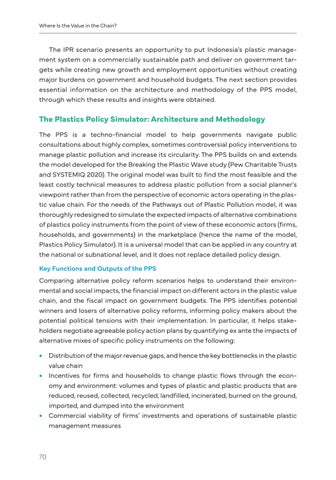Where Is the Value in the Chain?
The IPR scenario presents an opportunity to put Indonesia’s plastic management system on a commercially sustainable path and deliver on government targets while creating new growth and employment opportunities without creating major burdens on government and household budgets. The next section provides essential information on the architecture and methodology of the PPS model, through which these results and insights were obtained.
The Plastics Policy Simulator: Architecture and Methodology The PPS is a techno-financial model to help governments navigate public consultations about highly complex, sometimes controversial policy interventions to manage plastic pollution and increase its circularity. The PPS builds on and extends the model developed for the Breaking the Plastic Wave study (Pew Charitable Trusts and SYSTEMIQ 2020). The original model was built to find the most feasible and the least costly technical measures to address plastic pollution from a social planner's viewpoint rather than from the perspective of economic actors operating in the plastic value chain. For the needs of the Pathways out of Plastic Pollution model, it was thoroughly redesigned to simulate the expected impacts of alternative combinations of plastics policy instruments from the point of view of these economic actors (firms, households, and governments) in the marketplace (hence the name of the model, Plastics Policy Simulator). It is a universal model that can be applied in any country at the national or subnational level, and it does not replace detailed policy design. Key Functions and Outputs of the PPS Comparing alternative policy reform scenarios helps to understand their environmental and social impacts, the financial impact on different actors in the plastic value chain, and the fiscal impact on government budgets. The PPS identifies potential winners and losers of alternative policy reforms, informing policy makers about the potential political tensions with their implementation. In particular, it helps stakeholders negotiate agreeable policy action plans by quantifying ex ante the impacts of alternative mixes of specific policy instruments on the following: ••Distribution of the major revenue gaps, and hence the key bottlenecks in the plastic value chain ••Incentives for firms and households to change plastic flows through the economy and environment: volumes and types of plastic and plastic products that are reduced, reused, collected, recycled, landfilled, incinerated, burned on the ground, imported, and dumped into the environment ••Commercial viability of firms’ investments and operations of sustainable plastic management measures
70





